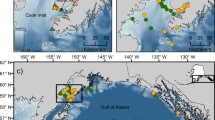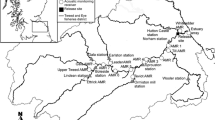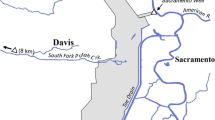Abstract
Few studies have examined the movement of adult Pacific salmon Oncorhynchus spp. between the sea and rivers after they have entered a river. In this study, archival tags that recorded temperature and salinity were attached to pink salmon (Oncorhynchus gorbuscha) that had ascended one of four rivers in northern Japan, to examine their individual movement patterns among fresh, brackish, and salt water. Of 44 pink salmon tagged and released in the rivers, nine were recaptured in the same river where they had been tagged and released, four were recaptured in marine nearshore trap fisheries, and one was recaptured in a neighboring river from where it was tagged and released. Among the 14 recaptured tagged fish, abrupt changes in salinity records were found in seven tag records, indicating that tagged fish had returned to brackish or seawater. Six of the seven individuals were males, and the sex ratio was biased toward males when compared with all tag-released individuals. The results suggest that a substantial proportion of homing adult pink salmon may make short-term movements between fresh and saltwater during their spawning migration. Analysis of the tag-recorded water temperatures showed significantly cooler riverine temperatures compared with inferred temperatures of the coastal water (up to 20.5 °C). While many factors, including orienting behavior and male-biased dispersal, likely influenced the observed ‘probing’ behavior, I speculate that the temporal use of freshwaters rivers may be a thermoregulatory behavior to avoid high, stressful temperatures. Future research relating the short-term movements between fresh water and salt water to local environmental conditions is needed to investigate this hypothesis.


Similar content being viewed by others
Data availability
The raw data are available from the author upon reasonable request.
Code availability
Not applicable.
References
Armstrong RH (1984) Migration of anadromous Dolly Varden charr in southeastern Alaska — a manager’s nightmare. In: Johnson L, Burns S (eds) Biology of the Arctic Charr: Proceedings of the International Symposium on Arctic Charr. University of Manitoba Press, Winnipeg, Manitoba, Canada, pp 559–570.
Birnie-Gauvin K, Thorstad EB, Aarestrup K (2019) Overlooked aspects of the Salmo salar and Salmo trutta lifecycles. Rev Fish Biol Fish 29:749–766. https://doi.org/10.1007/s11160-019-09575-x
Bennett TR, Roni P, Denton K, McHenry M, Moses R (2015) Nomads no more: early juvenile coho salmon migrants contribute to the adult return. Ecol Freshw Fish 24:264–275. https://doi.org/10.1111/eff.12144
Bond MH, Miller JA, Quinn TP (2015) Beyond dichotomous life histories in partially migrating populations: cessation of anadromy in a long-lived fish. Ecology 96:1899–1910. https://doi.org/10.1890/14-1551.1
Degerman E, Leonardsson K, Lundqvist H (2012) Coastal migrations, temporary use of neighbouring rivers, and growth of sea trout (Salmo trutta) from nine northern Baltic Sea rivers. ICES J Mar Sci 69:971–980. https://doi.org/10.1093/icesjms/fss073
Groot C, Margolis L (1991) Pacific salmon life histories. UBC Press, Vancouver, Canada
Gross MR, Coleman RM, McDowall RM (1988) Aquatic productivity and the evolution of diadromous fish migration. Science 239:1291–1293
Hendry AP, Bohlin T, Jonsson B, Berg OK (2004) To sea or not to sea? Anadromy versus non-anadromy in salmonids. In: Hendry AP, Stearns SC (eds) Evolution illuminated: salmon and their relatives. Oxford University Press, New York, pp 92–125
Hutchings JA, Gerber L (2002) Sex-biased dispersal in a salmonid fish. Proc Royal Soc London B 269:2487–2493. https://doi.org/10.1098/rspb.2002.2176
Jeffries KM, Hinch SG, Sierocinski T, Pavlidis P, Miller KM (2014) Transcriptomic responses to high water temperature in two species of Pacific salmon. Evol Appl 7:286–300. https://doi.org/10.1111/eva.12119
Jensen JLA, Rikardsen AH (2012) Archival tags reveal that Arctic charr Salvelinus alpinus and brown trout Salmo trutta can use estuarine and marine waters during winter. J Fish Biol 81:735–749. https://doi.org/10.1111/j.1095-8649.2012.03343.x
Jensen AJ, Diserud OH, Finstad B, Fiske P, Rikardsen AH, Jonsson B (2015) Between-watershed movements of two anadromous salmonids in the Arctic. Can J Fish Aquat Sci 72:855–863. https://doi.org/10.1139/cjfas-2015-0015
Kume M, Nakayama N, Iwasaki Y, Hori T, Watanabe S, Terashima Y, Medo A, Arai N, Yamashita Y, Mitamura H (2021) River to river: first evidence of eel movement between distant rivers via the sea. Environ Biol Fish 104:529–533. https://doi.org/10.1007/s10641-021-01090-y
Kuroki M, Tsukamoto K (2012) Eels on the move. Tokai University Press, Hadano, Kanagawa, Japan
Kuroki M, Tamate T, Morita K (2020) An additionalm life-history tactic of masu salmon: Migration of parr to coastal habitats. Ecol Freshw Fish 29:495–501. https://doi.org/10.1111/eff.12544
Maselko JM, Wertheimer AC, Thedinga, JF (1999) Estimating probing behavior of pink salmon. Proceedings of the 19th Pink and Chum Salmon Workshop, Juneau, Alaska, National Marine Fisheries Service. pp. 40–48.
Maselko JM, Wertheimer AC, Thedinga JF (2003) Selection and application of a mark-and-recapture technique for estimating pink salmon escapements. U.S. Dept Commer, NOAA Tech Memo NMFS-AFSC-137, 44 p.
McDowall RM (1987) The occurrence and distribution of diadromy among fishes. In: Dadswell MJ, Klauda RJ, Moffitt CM, Saunders RL, Rulifson RA, Cooper JE (eds) Common strategies of anadromous and catadromous fishes. American Fisheries Society, Bethesda, Maryland, pp 1–13
Miyata N, Mori T, Kagehira M, Miyazaki N, Suzuki M, Sato K (2016) Micro CTD data logger reveals short-term excursions of Japanese sea bass from seawater to freshwater. Aquat Biol 25:97–106. https://doi.org/10.3354/ab00656
Morita K, Morita SH, Nagasawa T, Kuroki M (2013) Migratory patterns of anadromous white-spotted charr Salvelinus leucomaenis in eastern Hokkaido, Japan: the solution to a mystery? J Ichthyol 53:809–819. https://doi.org/10.1134/S0032945213100068
Ohnuki T, Morita K, Tokuda H, Okamoto Y, Ohkuma K (2015) Numerical and economic contributions of wild and hatchery pink salmon to commercial catches in Japan estimated from mass otolith markings. N Am J Fish Manag 35:598–604. https://doi.org/10.1080/02755947.2015.1020078
Quinn TP (2018) The behavior and ecology of Pacific salmon and trout. University of Washington Press, Seattle
Radchenko VI, Beamish RJ, Heard WR, Temnykh OS (2018) Ocean ecology of pink salmon. In: Beamish RJ (ed) The ocean ecology of Pacific salmon and trout. American Fisheries Society, Bethesda, pp 15–160
Radtke R, Svenning M, Malone D, Klementsen A, Ruzicka J, Fey D (1996) Migrations in an extreme northern population of Arctic charr Salvelinus alpinus: insights from otolith microchemistry. Mar Ecol Prog Ser 136:13–23. https://doi.org/10.3354/meps136013
Taal I, Rohtla M, Saks L, Kesler M, Jürgens K, Svirgsden R, Matetski L, Verliin A, Paiste P, Vetemaa M (2018) Parr dispersal between streams via a marine environment: a novel mechanism behind straying for anadromous brown trout? Ecol Freshw Fish 27:209–215. https://doi.org/10.1111/eff.12338
Takami T (1998) Seawater tolerance of white-spotted charr (Salvelinus leucomaenis) related to water temperature. Sci Rep Hokkaido Fish Hatchery 52:11–19
Thedinga JF, Wertheimer AC, Heintz RA, Maselko JM, Rice SD (2000) Effects of stock, coded-wire tagging, and transplant on straying of pink salmon (Oncorhynchus gorbuscha) in southeastern Alaska. Can J Fish Aquat Sci 57:2076–2085. https://doi.org/10.1139/f00-163
Thorpe JE (1987) Smolting versus residency: developmental conflict in salmonids. In: Dadswell MJ, Klauda RJ, Moffitt CM, Saunders RL, Rulifson RA, Cooper JE (eds) Common strategies of anadromous and catadromous fishes. American Fisheries Society, Bethesda, Maryland, pp 244–252
Walker RV, Davis ND, Myers KW, Helle JH (2005) New information from archival tags from Bering Sea tagging, 1998–2004. N Pac Anadr Fish Tech Rep 6:38–40
Acknowledgements
I would like to thank Genki Sahashi, the staff of the Hokkaido National Fisheries Research Institute, the Tokushibetsu Hatchery, the Soya Salmon Enhancement Program Association, and the Esashi Fishery Cooperative for their cooperation with the tagging study.
Funding
This work was supported by general research funds from the Japan Fisheries Research and Education Agency.
Author information
Authors and Affiliations
Contributions
The author conducted the research, analyzed the data, and wrote the paper.
Corresponding author
Ethics declarations
Ethics approval
The survey was conducted with the permission of the Governor of Hokkaido, Japan; the tagged fish were handled appropriately.
Consent to participate
Not applicable.
Consent for publication
The author consents to publication of this study.
Conflicts of interest
The author declares no conflict of interests.
Additional information
Publisher's note
Springer Nature remains neutral with regard to jurisdictional claims in published maps and institutional affiliations.
Rights and permissions
About this article
Cite this article
Morita, K. Reverse migration of adult pink salmon (Oncorhynchus gorbuscha) to the sea after their return to fresh water. Environ Biol Fish 105, 1825–1832 (2022). https://doi.org/10.1007/s10641-021-01139-y
Received:
Accepted:
Published:
Issue Date:
DOI: https://doi.org/10.1007/s10641-021-01139-y




